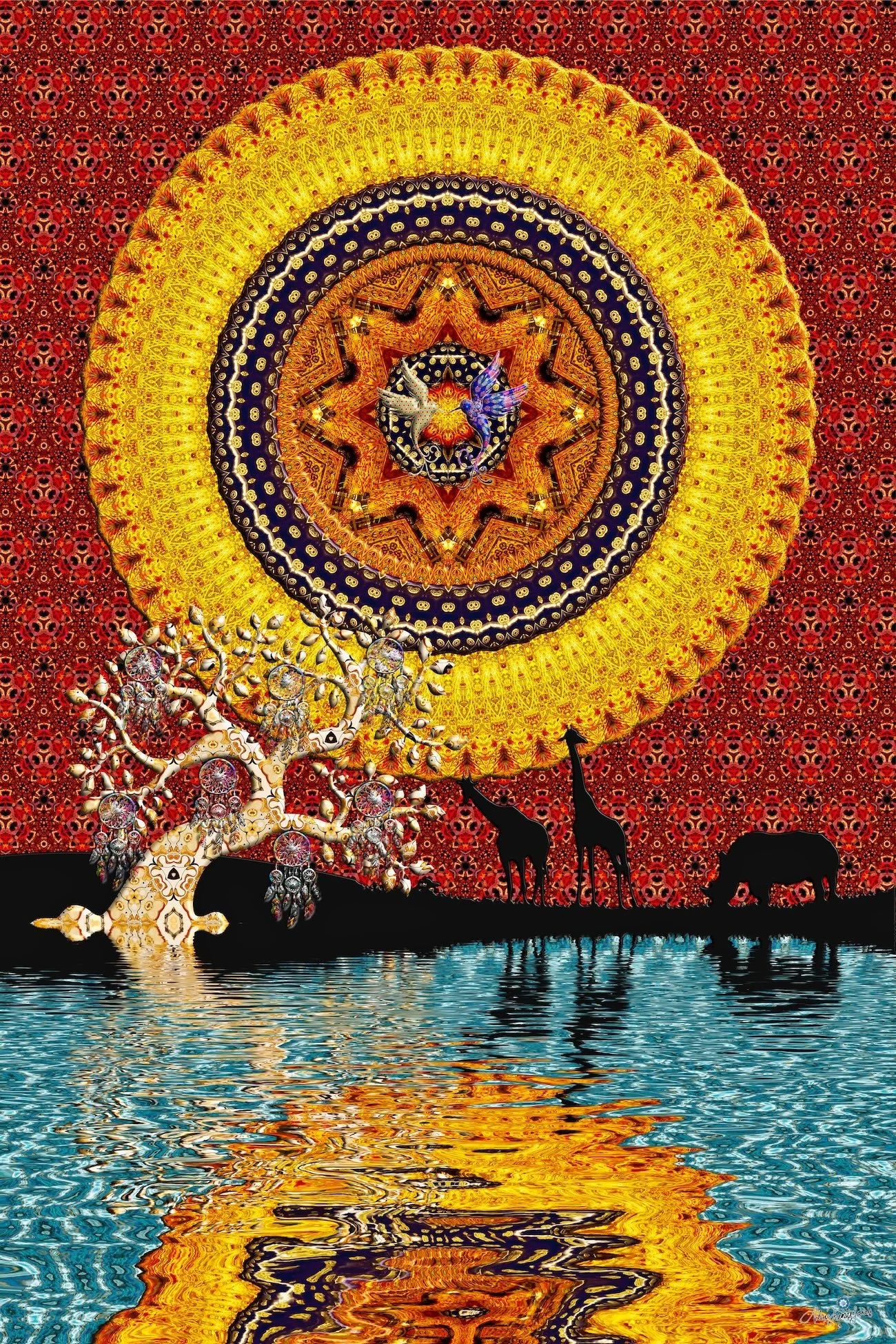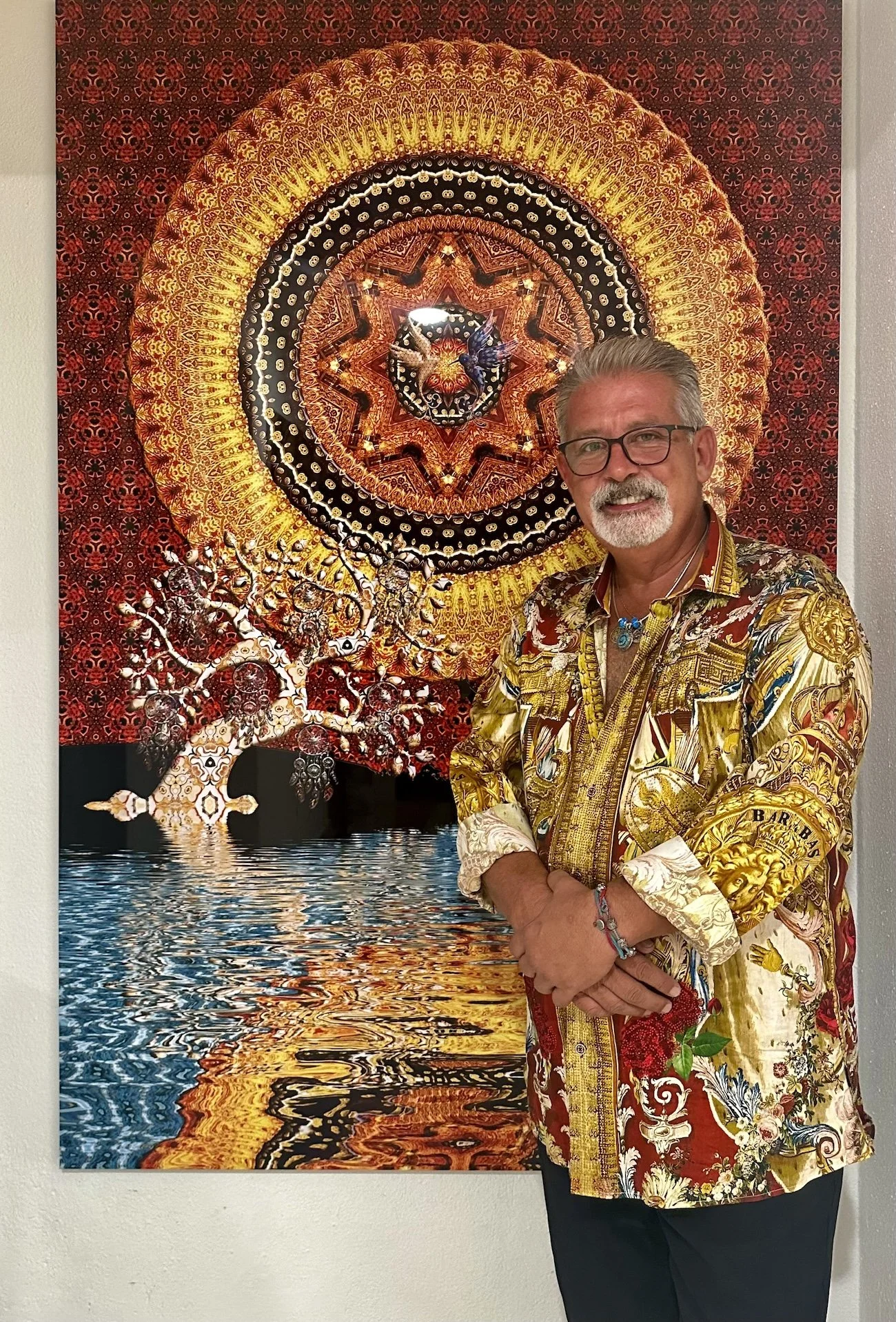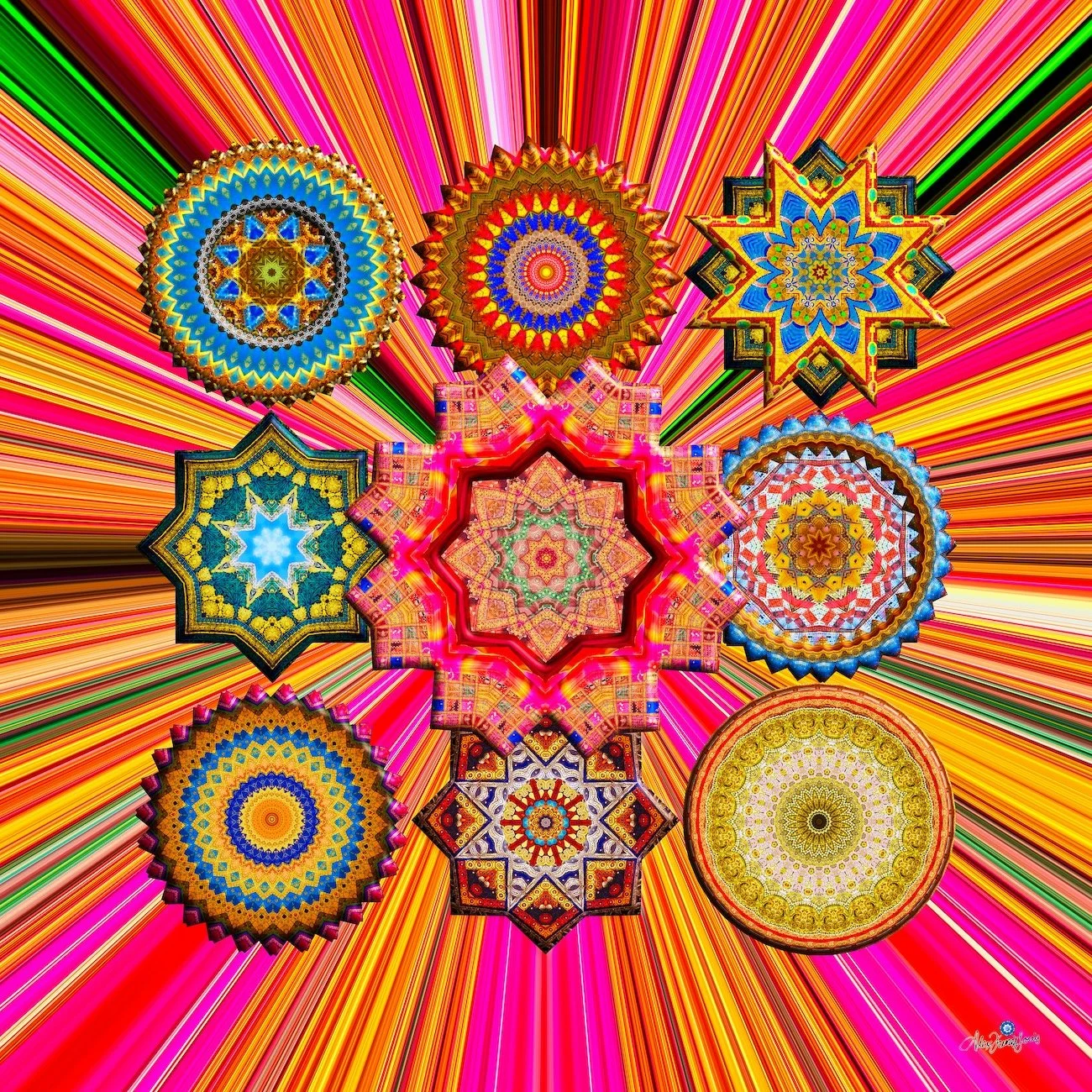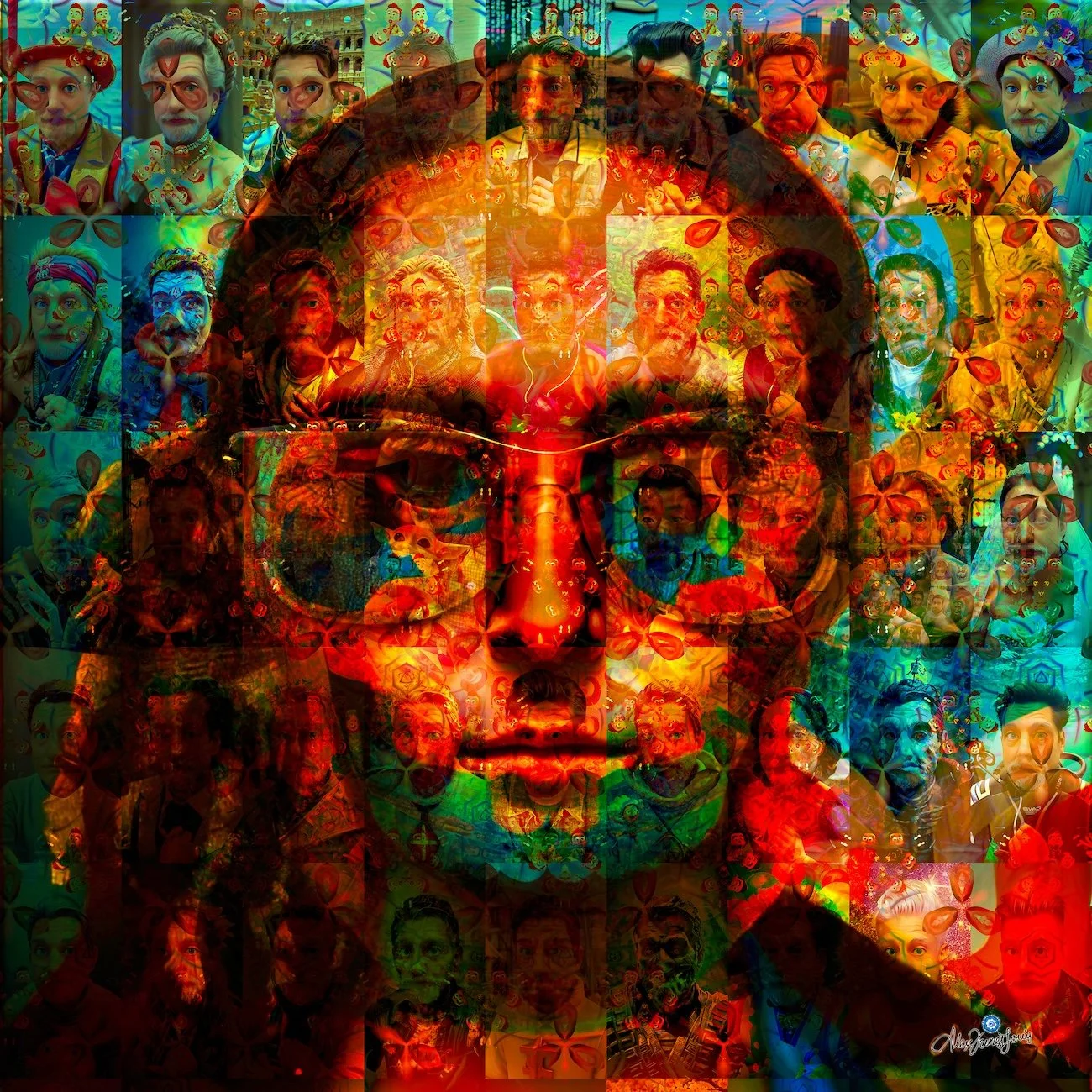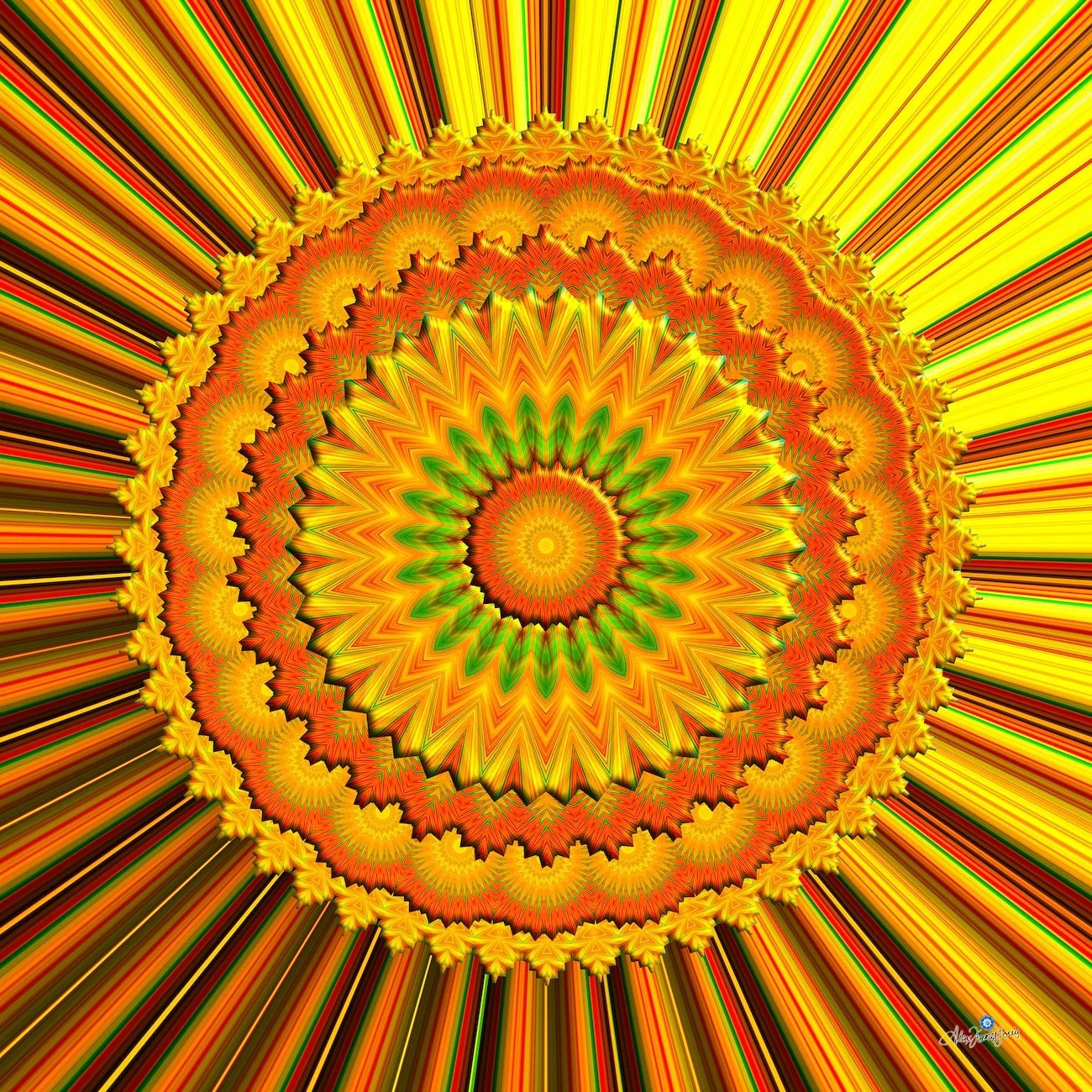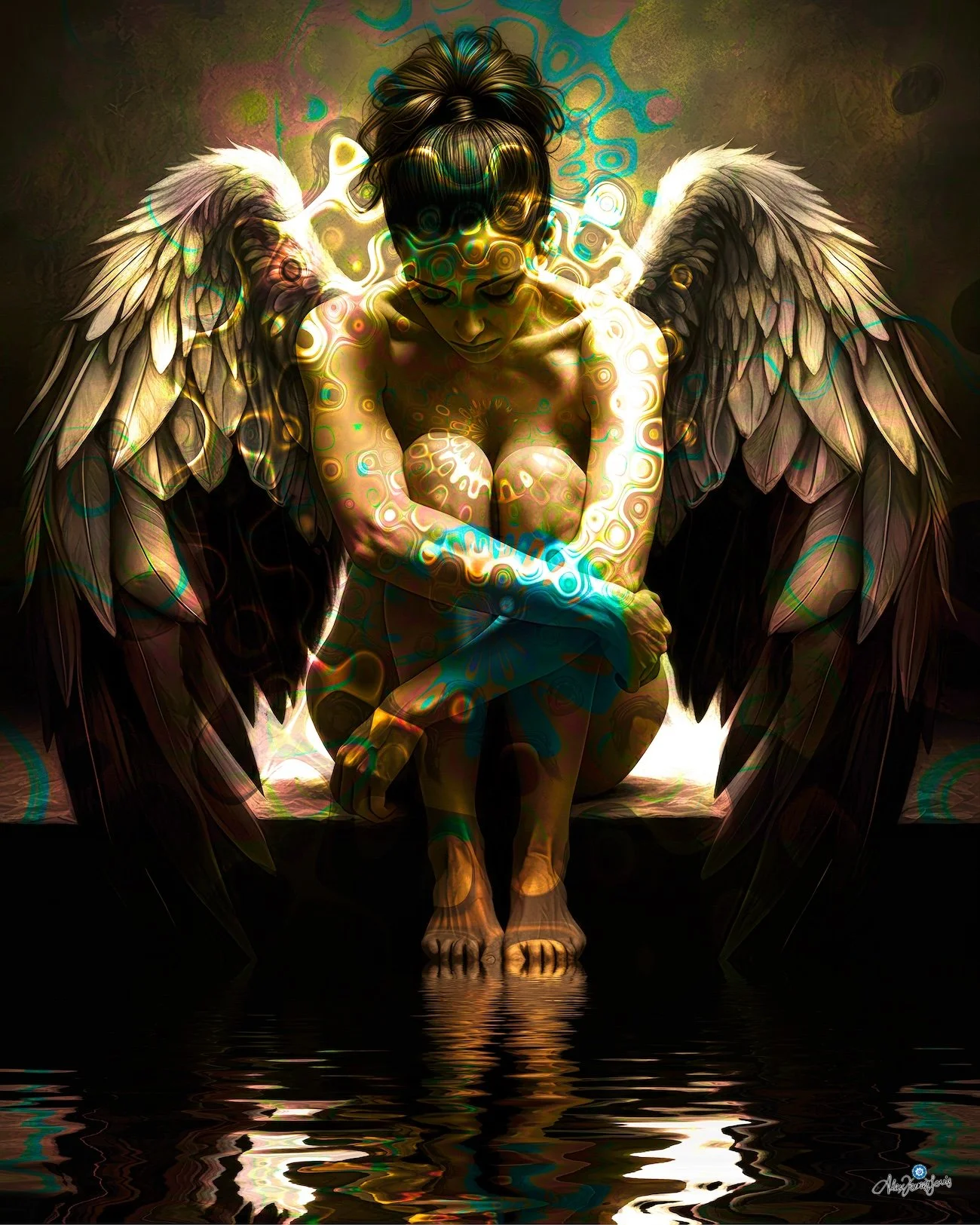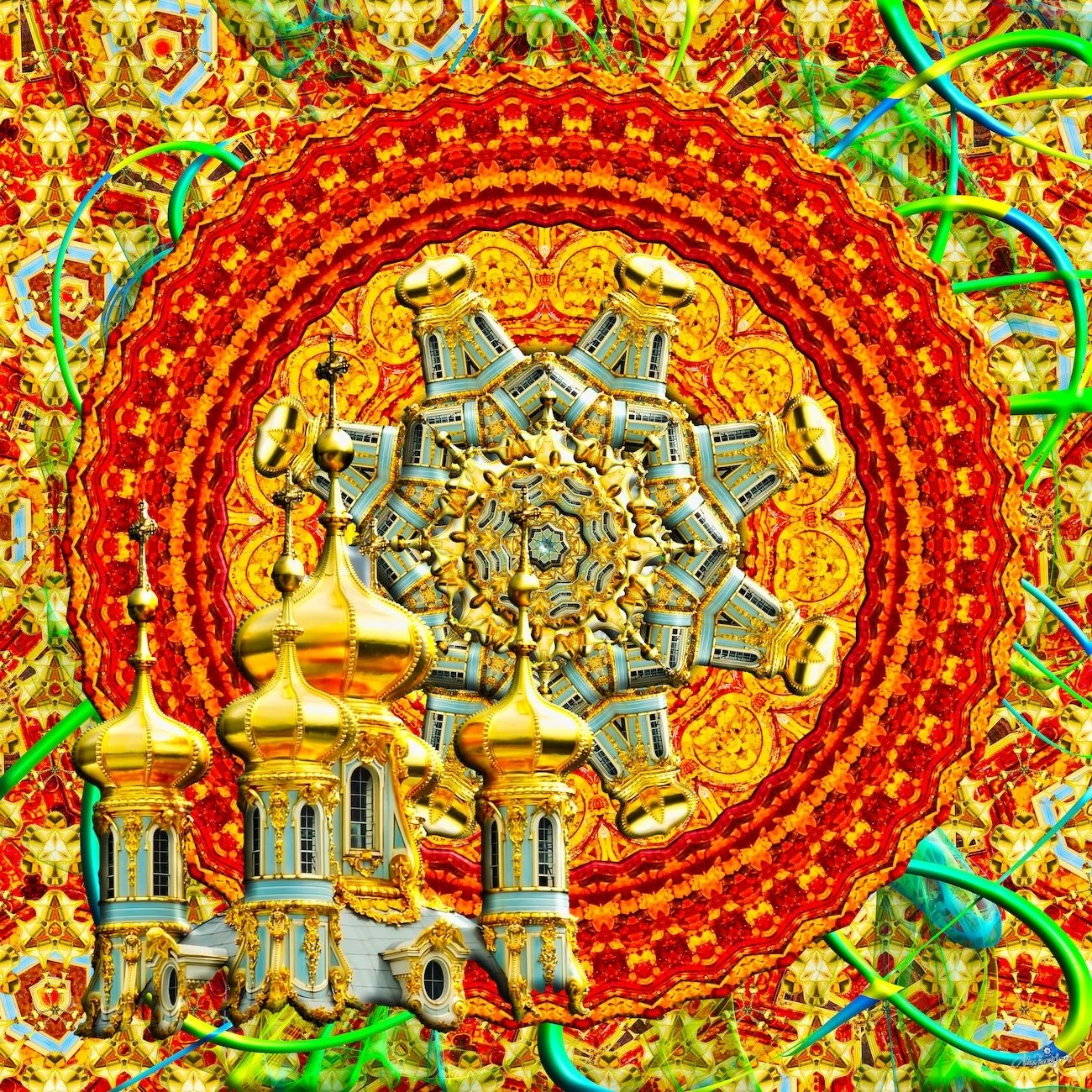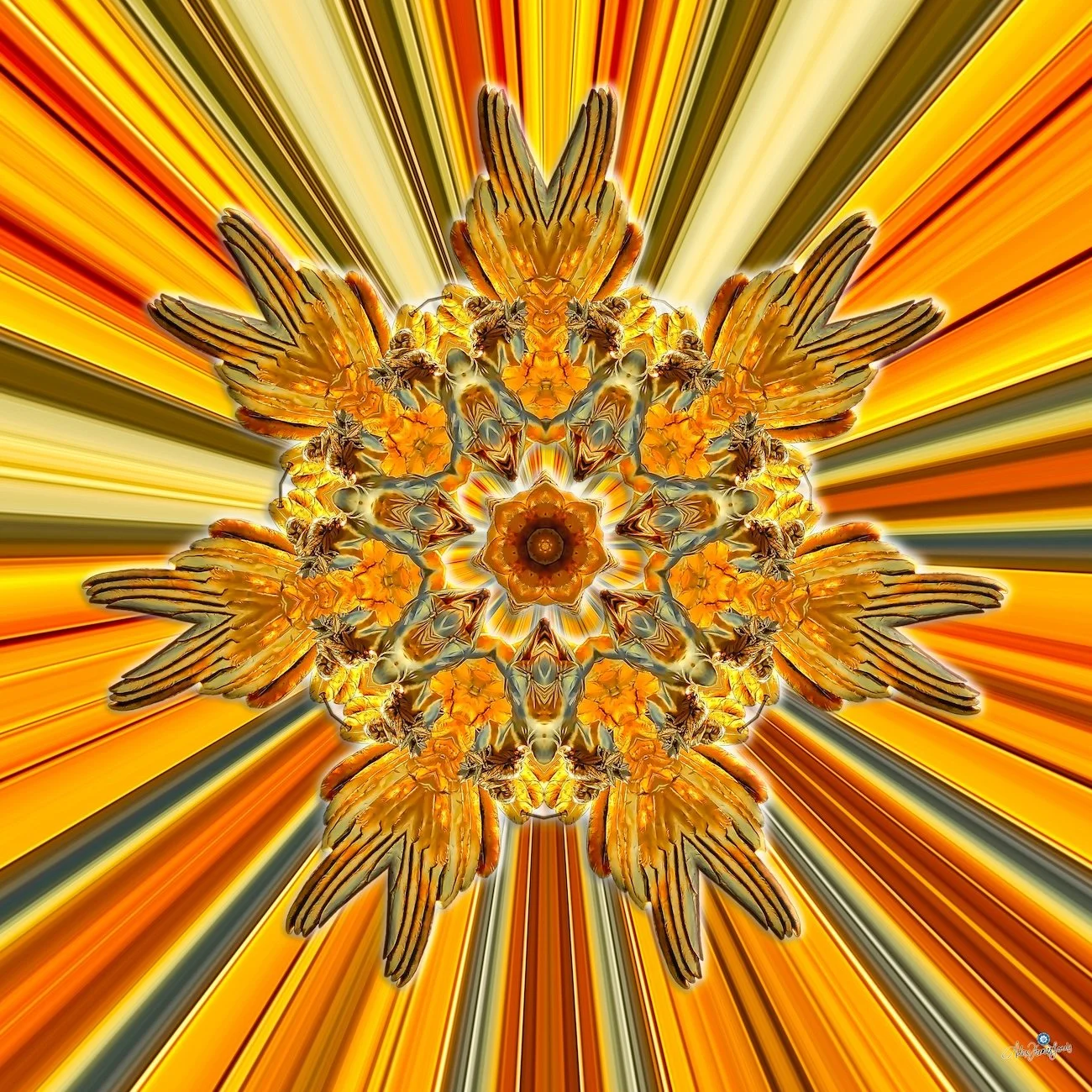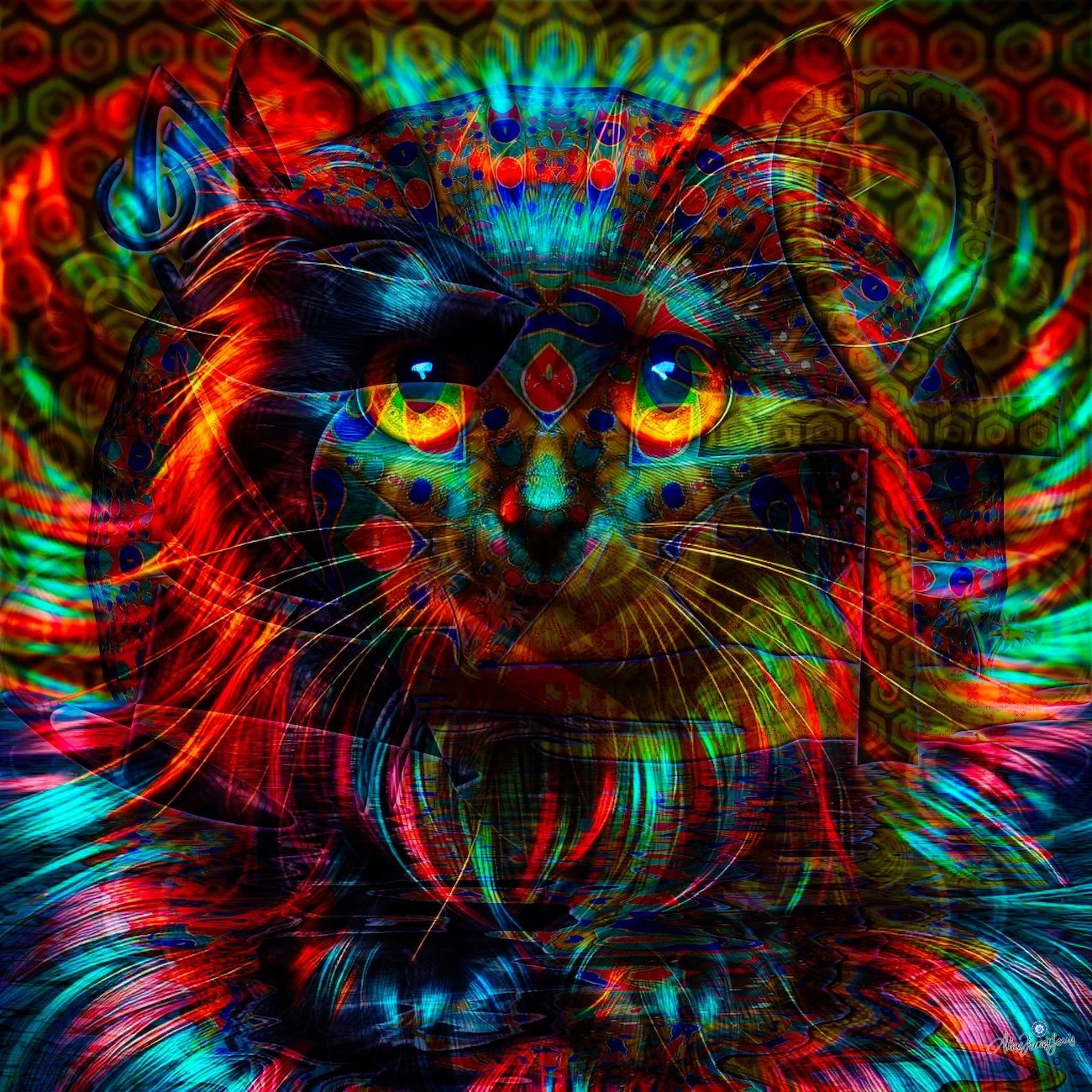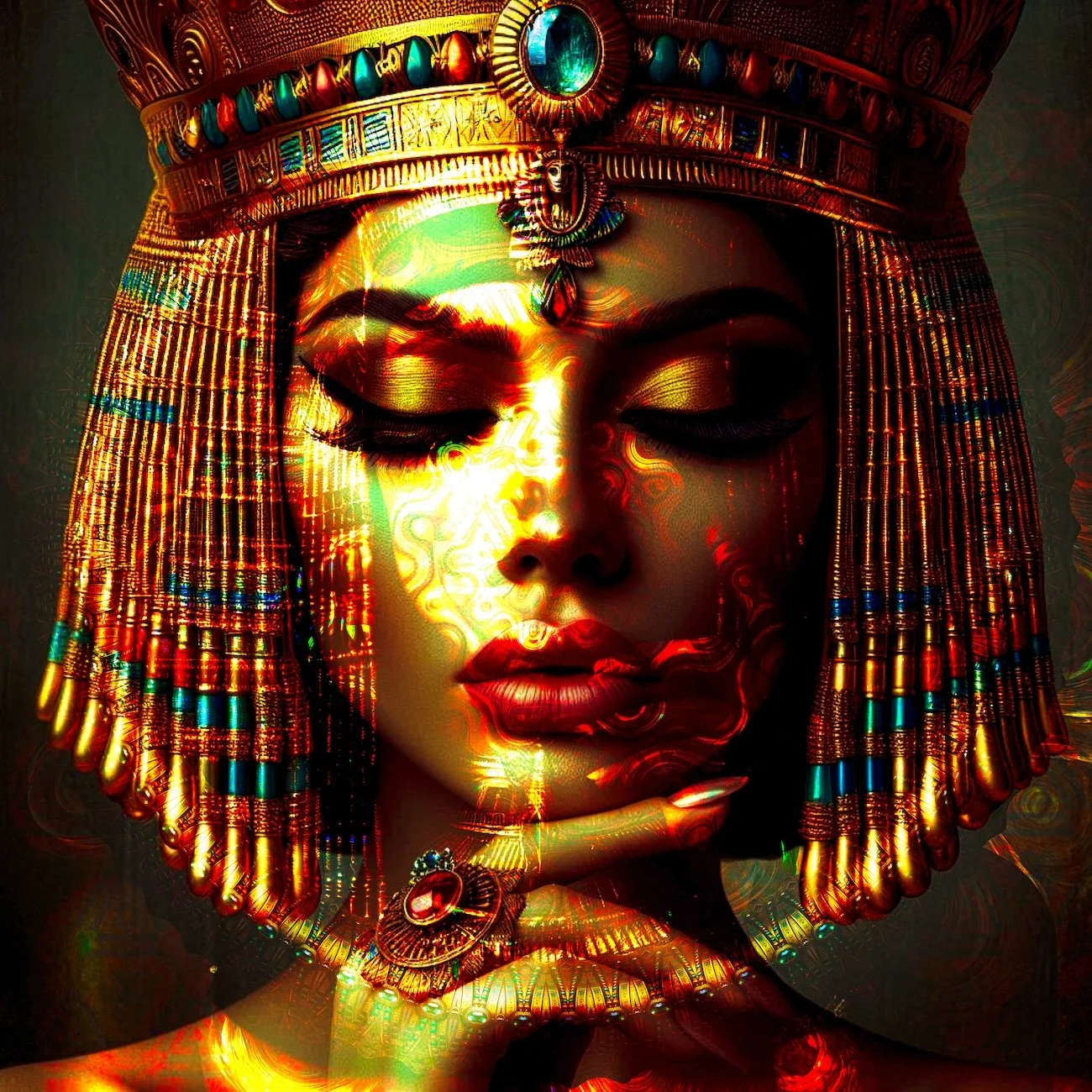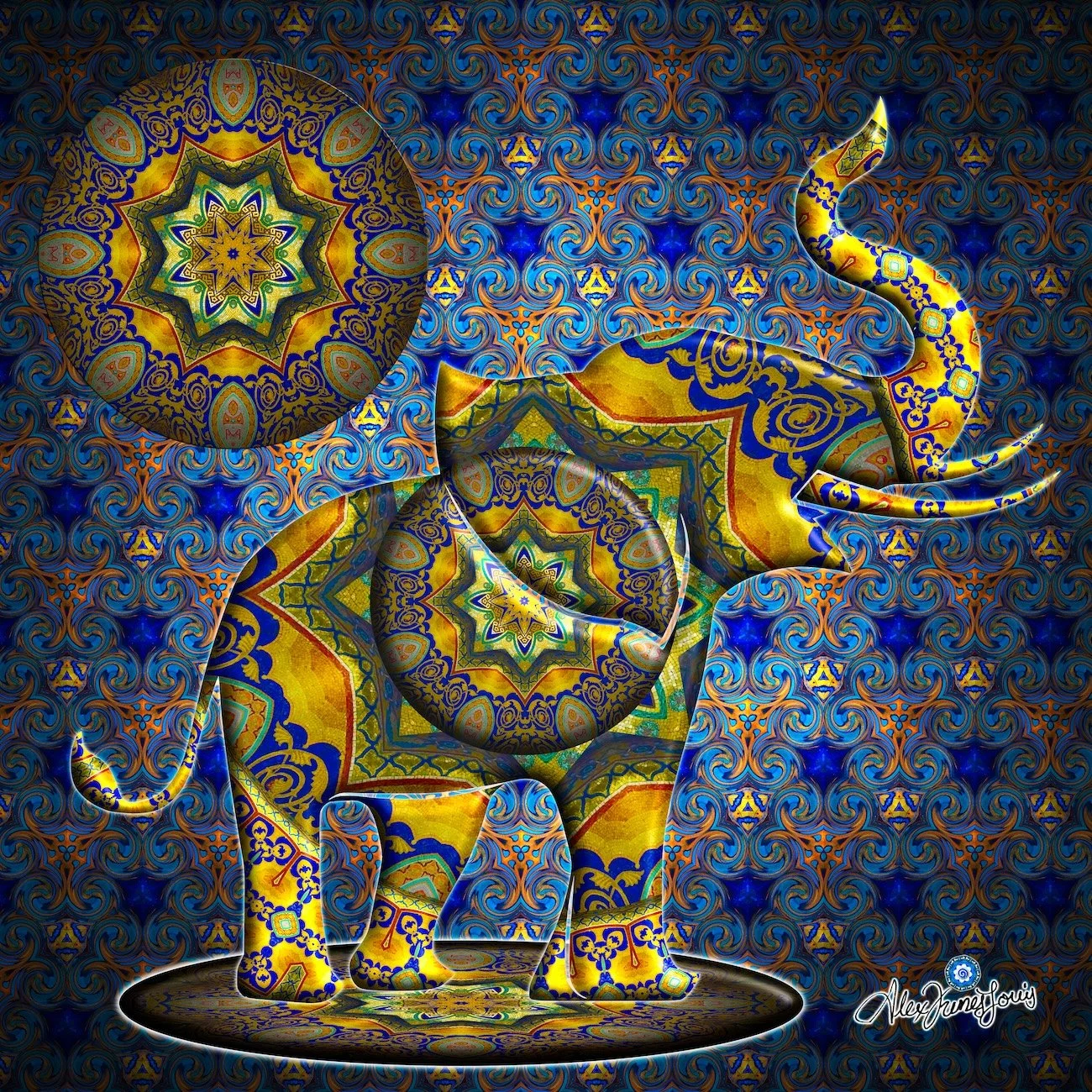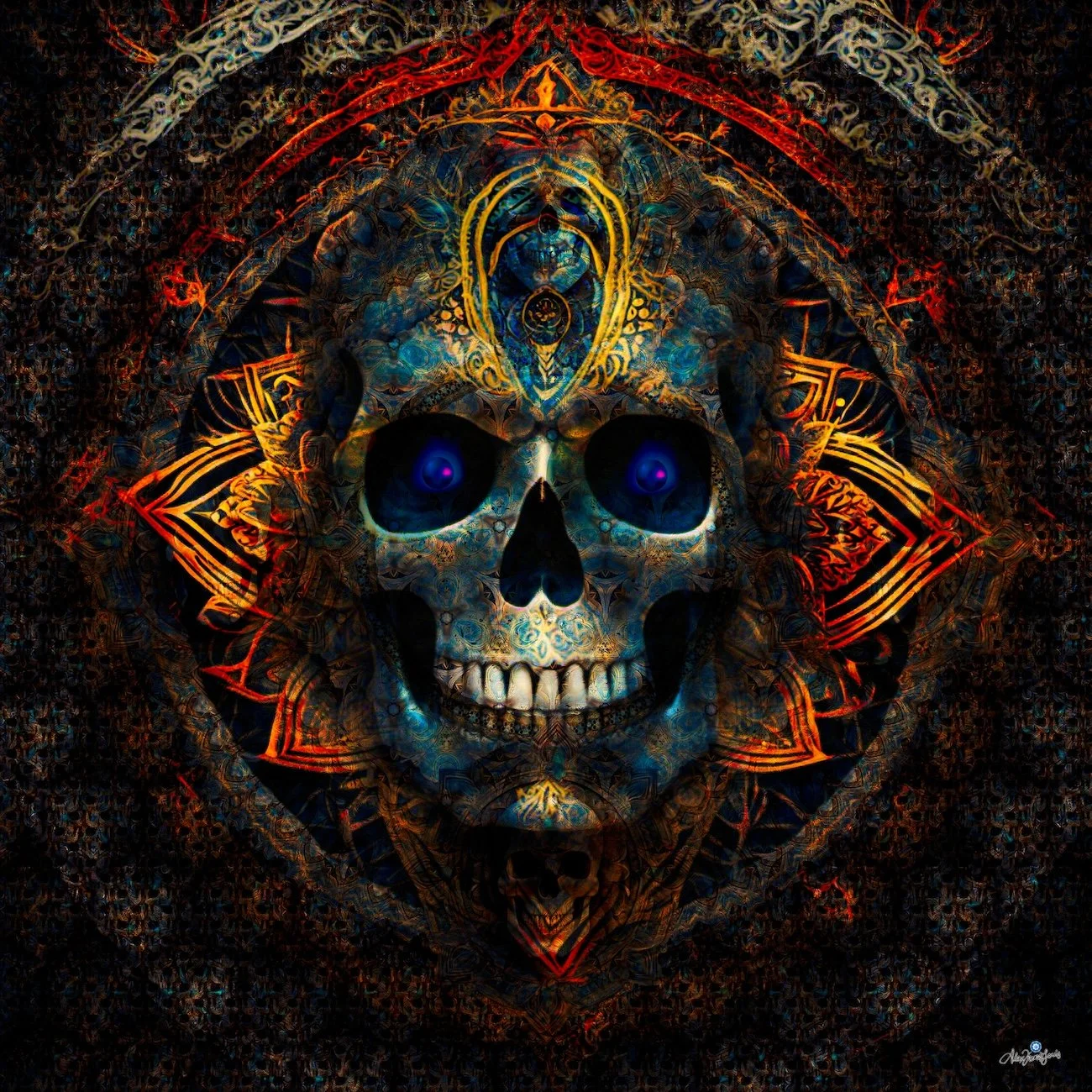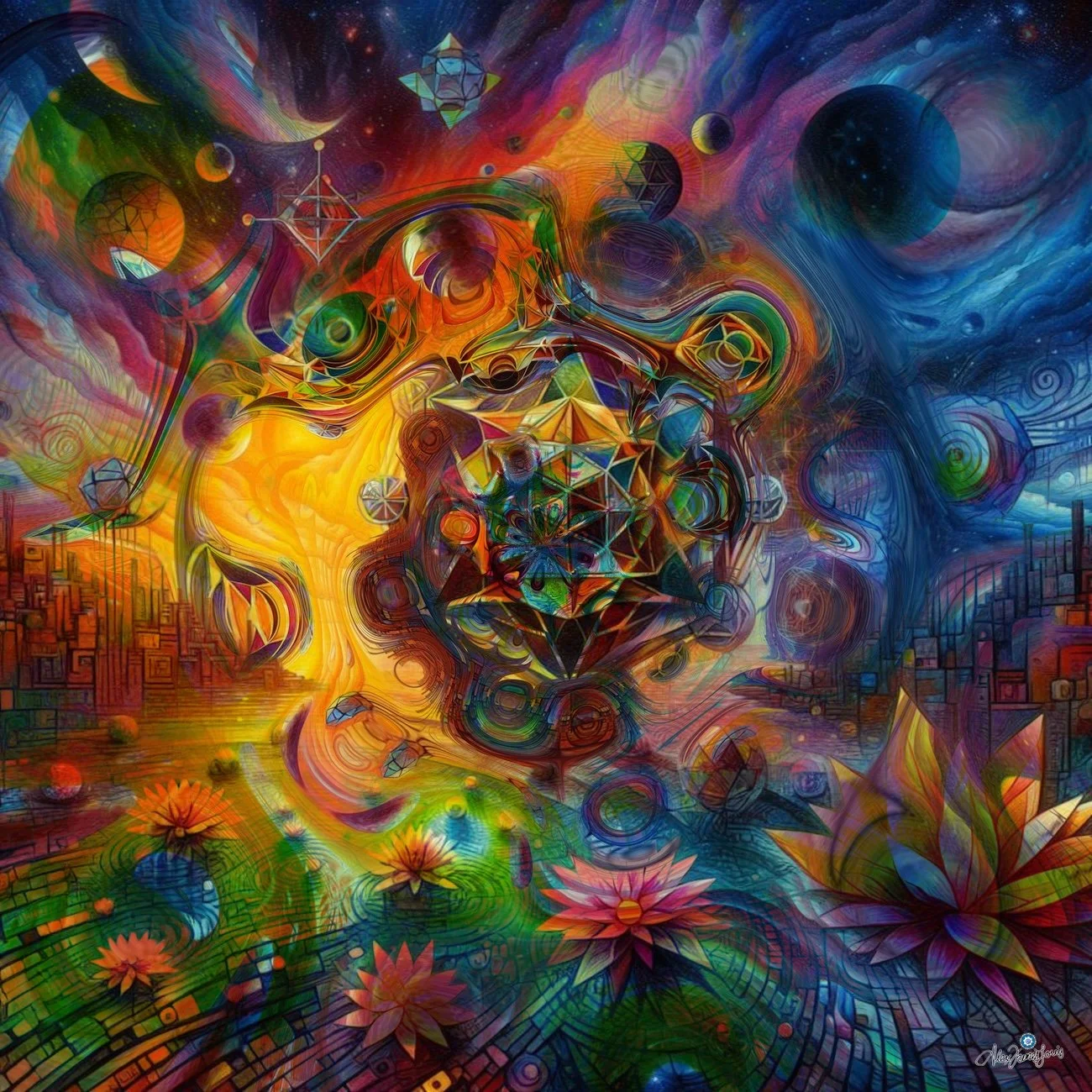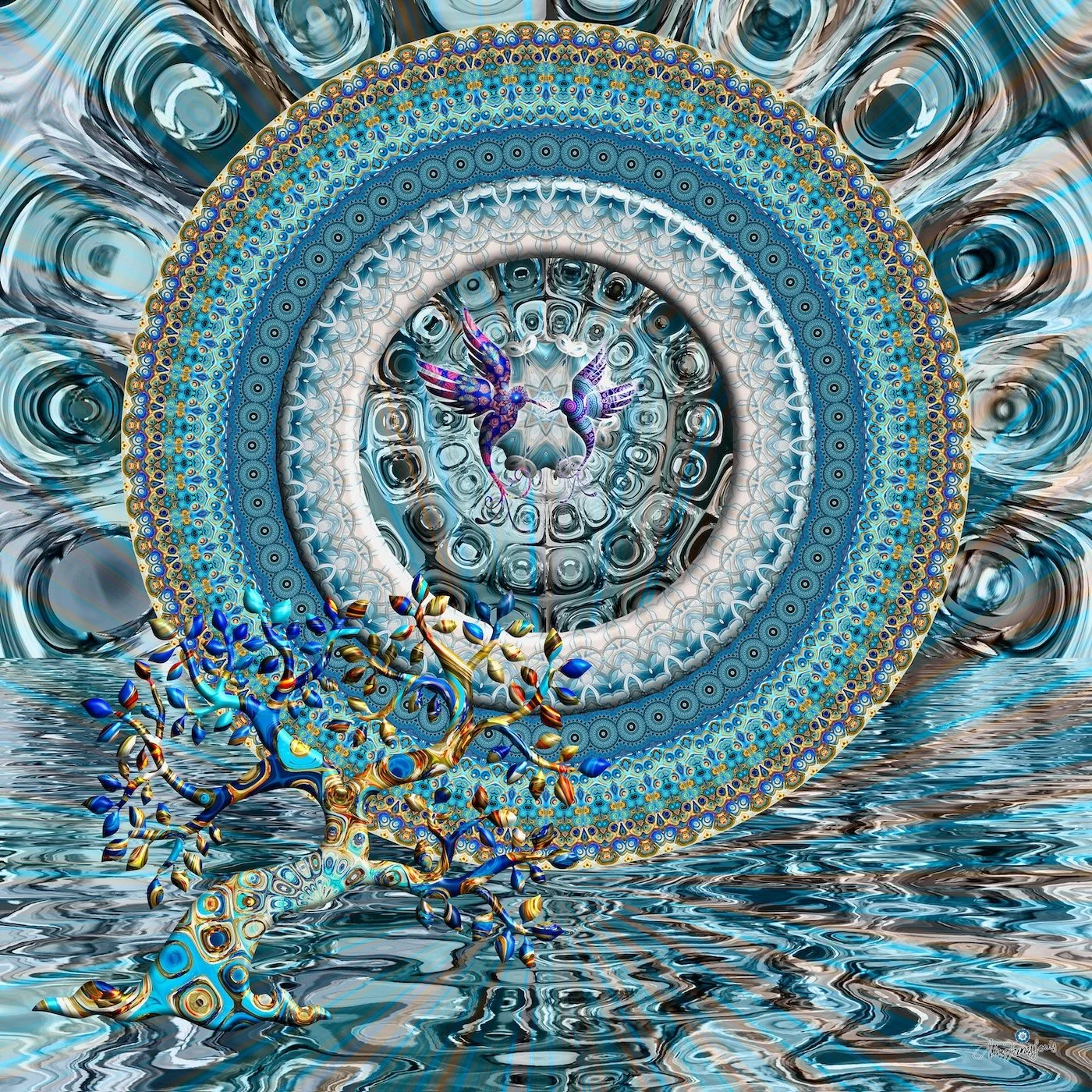Interview with Alex Funes
Alex, your work seamlessly integrates sacred geometry, vibrant colors and numerology with the rich visual heritage of the places you have visited. Could you elaborate on the intricate process you go through when creating a piece that fuses these various elements? Specifically, how do you decide which cultural motifs, geometric patterns, and color schemes to incorporate from each location, and what role does intuition play in this creative process?
My creative process begins with deep research into the cultures and places I visit. I immerse myself in their history, symbology and traditional art to understand the elements that are significant to those cultures. This allows me to identify cultural motifs and geometric patterns that resonate with the essence of each place.
Once I have a solid understanding, I choose the items that best represent the spirituality and symbolism of the culture in question. Sacred geometry is an essential aspect of my work, as I believe these universal geometric patterns are a common language that connects all cultures. Therefore, I look for ways to integrate these patterns with the specific cultural motifs of each place, creating a harmony between the universal and the particular.
The use of color is also a crucial part of my process. Each culture has a distinctive color palette that is loaded with symbolism and meaning. When choosing color schemes, I try to capture the emotional essence of the culture and place, ensuring that the colors are not only visually appealing but also resonate with the viewer on a deeper level.
Intuition plays a fundamental role in my creative process. Although research and planning are important, I let my intuition guide the final integration of all of these elements. Often, it is in this intuitive moment where the true magic happens, where all the elements align to create a piece that is not only visually stunning but also spiritually resonant. I trust my instincts to know when a piece is complete and when it conveys the message and energy I want to share
You often describe your intention as inducing a deep experience in the viewer's heart. Could you share any memorable comments or transformative experiences from your audience that have deeply impacted you and perhaps influenced your subsequent work? How do these interactions shape your understanding of the emotional and spiritual resonance of your art?
One of the most memorable experiences I have had with my audience occurred at an exhibition where I presented a series of works inspired by sacred geometry and numerology. A visitor approached me, visibly excited, and shared that one of the pieces had evoked memories of a deep meditation she had experienced years before. He explained to me how the patterns and colors of the work reminded him of a vision he had during that meditation, where he felt a deep connection with the universe. This experience was transformative for her and provided her with a sense of peace and clarity that she had been seeking ever since.
These types of interactions impact me deeply because they remind me of the power of art to touch intimate and personal aspects of our lives. It motivates me to continue exploring spiritual and emotional themes in my work, knowing that my pieces can resonate meaningfully with people's inner experiences.
Additionally, these audience encounters have led me to reflect on the emotional and spiritual resonance of my art. I have realized that when I create from a place of authenticity and personal connection, art has a greater ability to touch others. This has led me to delve deeper into my own spiritual and emotional process, constantly seeking ways to express these experiences through my work.
By receiving this type of feedback and seeing how my art can spark transformative experiences, I am inspired to continue exploring and sharing these topics. It also drives me to create spaces in my works that allow the viewer to project their own experiences and find their own meanings. Ultimately, these interactions reinforce my conviction that art is not only a form of expression, but also a powerful tool for spiritual connection and growth.
How has your Mexican heritage influenced your artistic vision and style, particularly in the realm of digital art and photography? Are there specific cultural traditions, personal experiences, or historical contexts from your childhood that continue to shape your work today? How do you navigate between honoring your roots and exploring new artistic territories?
My Mexican heritage has been a fundamental influence on my artistic vision and style, especially in digital art and photography. Growing up in Mexico exposed me to a rich cultural tradition full of vibrant colors, deep symbolism, and a strong connection to spirituality and nature. These influences are evident in my use of color and form, as well as in the themes I explore in my work.
Specific cultural traditions, such as the Day of the Dead and the use of pre-Hispanic symbols, have been particularly influential. Día de los Muertos, with its colorful altars and offerings to deceased loved ones, has taught me about celebrating life and death in a way that is both festive and reverent. This approach to death as a transition rather than an ending is reflected in my work, which often explores themes of transformation and rebirth.
Additionally, my childhood was marked by exposure to Mexican folk art, such as alebrijes and murals, which are rich in symbolic details and visual narratives. These experiences have shaped my approach to digital art and photography, where I seek to integrate layers of meaning and symbolism into each piece.
Navigating between honoring my roots and exploring new artistic territories is a constant process of balance. I feel a deep responsibility to represent my heritage authentically and respectfully, ensuring that my work reflects the cultural richness of Mexico. At the same time, I am open to exploring new techniques and concepts that transcend cultural boundaries. In this sense, digital technology has been a powerful tool for combining the traditional with the contemporary, allowing me to create works that are both an homage to my heritage and an exploration of new ideas and possibilities.
To achieve this balance, I strive to be in a constant state of learning and adapting. I research and get involved with other cultures and artistic currents, which allows me to expand my perspective without losing sight of my roots. Ultimately, my goal is to create a dialogue between the traditional and the modern, the local and the global, where my art can resonate with a diverse audience while maintaining a deep connection to my cultural identity.
Your work is described as a journey that bridges physical, emotional, and spiritual realms. Can you discuss in detail how your extensive travels have informed your artistic narrative? How do you choose the destinations that inspire your creations, and what are some of the most impactful experiences you've had while exploring these places? How do these experiences translate into your art?
My travels have been an endless source of inspiration and have significantly shaped my artistic narrative. By exploring different cultures and landscapes, I have discovered a variety of symbols, patterns and philosophies that inform and enrich my work. My creations are the result of a fusion of these experiences, where I seek to capture not only the visual beauty of a place, but also its emotional and spiritual essence.
Choosing the destinations that inspire my creations is often an intuitive process. I am drawn to places with rich cultural history, deep spirituality, and a strong connection to nature. I often do research before traveling to identify unique cultural and spiritual elements that might resonate with me and my work. However, I also leave room for spontaneity and surprise, allowing me to discover unexpected aspects of a place that could inspire new directions in my art.
One of the most impactful experiences I have had was on a trip to Türkiye. The richness of colors, intricate architecture, and deep spirituality of the place left a lasting impression on me. In particular, the experience of visiting ancient temples and participating in local rituals (Dervish Dancers), connected me very deeply with the energy and devotion of the place. This experience translated into my work through the use of vibrant colors and geometric patterns inspired by Turkish architecture, as well as the exploration of themes of devotion and spiritual transcendence.
Another example was my visit to the Mayan ruins in Mexico. Being surrounded by the ancient pyramids and structures, and learning more about the Mayan worldview, made me reflect on the connection between humanity and the cosmos. This experience inspired me to incorporate elements of astronomy and cosmology into my work, exploring how ancient civilizations understood and represented their place in the universe.
These experiences translate into my art not only visually, but also in terms of the narrative and themes I explore. Each work is a reflection on the intersections between the physical, the emotional and the spiritual, and how these aspects intertwine to form our understanding of the world. Through my work, I invite the viewer to embark on a similar journey, exploring these realms introspectively and finding their own meaning in the images and symbols I present.
In short, my travels have allowed me to expand my perspective and enrich my artistic narrative, infusing my work with a diversity of cultural and spiritual influences. These trips not only fuel my creativity, but also help me grow as an individual, deepening my understanding of humanity and our connection to the world.
The mysticism of numerology is a unique aspect of your art. How do you incorporate numerological principles into your work and what meaning do these numbers have for you personally and for your audience? Can you provide an example of a piece where numerology played a pivotal role in its conception and creation?
I incorporate the principles of numerology into my art in several ways, using numbers as symbols that add layers of meaning to my works. Numerology, which attributes mystical and spiritual meanings to numbers, offers me a way to explore deeper concepts and connect with the subconscious on both a personal and collective level. To me, numbers not only represent quantities or measurements, but they also symbolize vibrations and energies that can influence our lives and experiences.
When creating a work, I often begin with research into the meaning of certain numbers and how they relate to the topic I want to explore. This may include exploring specific numbers that have cultural or spiritual meanings in different traditions. I then incorporate these numbers symbolically into the composition, structure, or even the choice of visual elements in the work.
For example, one of my pieces titled "The Bridge of Eight Steps" focuses on the number eight, which in numerology is associated with balance, abundance, and infinity. The number eight is considered a symbol of power and success, and its continuous loop shape represents the idea of endless cycles and eternity. In this work, the number eight is represented through a series of eight geometric figures that are repeated in the background, creating a feeling of continuity and balance. Additionally, I used a color palette that includes eight different shades, each associated with different aspects of prosperity and stability.
The meaning of the number eight was deliberately chosen to resonate with the theme of the work, which is about the journey towards personal achievement and inner balance. By using numerology in this way, I invite the viewer to reflect on their own cycles of success and balance in life. For me, this number has personal meaning as it represents times when I have found stability and success in my own life. By sharing this work with audiences, I hope viewers can also find resonance with their own experiences of growth and balance.
In short, numerology is a powerful tool that I use to imbue my works with additional meaning and symbolism. Through the incorporation of numbers and their meanings, I seek to create a deeper connection between the work and the viewer, offering a space for reflection and spiritual exploration.
In a rapidly evolving digital art landscape, how do you envision your work evolving over the next decade? Are there emerging technologies or innovative techniques that you are particularly excited to explore? How do you plan to integrate these advances while maintaining the emotional and spiritual depth that defines your work?
Over the next decade, I see my work evolving in several exciting directions, driven by the advancement of new technologies and techniques in the realm of digital art. I am particularly excited to explore the potential of augmented reality (AR), virtual reality (VR) and artificial intelligence (AI) in my art practice. These emerging technologies offer unprecedented possibilities for creating immersive, personalized experiences that can transport viewers to new and meaningful worlds.
Augmented reality and virtual reality, in particular, intrigue me because they allow artists to expand the boundaries of physical space and create interactive environments. I envision creating immersive art installations that not only display my works in a digital format, but also allow viewers to interact with them in a meaningful way. For example, a piece could be experienced as a guided meditation in a virtual space, where viewers can move and explore visual and sound elements that respond to their movements and actions.
Artificial intelligence also offers exciting opportunities for generative art and personalization. I am interested in how AI algorithms can collaborate with me to create new shapes and patterns based on principles of sacred geometry and numerology, generating works that evolve in real time. Additionally, AI could help personalize artistic experiences for viewers, creating works that respond to their emotions and mental states.
Despite these exciting technological possibilities, it is essential for me to maintain the emotional and spiritual depth that defines my work. To achieve this, I plan to use these technologies not only as technical tools, but as means to deepen the connection between art and viewer. Technology can expand the experience of art, but the core of my work will continue to be the exploration of universal themes such as spirituality, human connection, and the inner journey.
In this sense, each technological advance will be integrated with a clear intention and spiritual purpose. For example, virtual reality experiences can be designed as meditative spaces that guide viewers through an introspective journey, while artificial intelligence can be used to explore numerical and symbolic patterns that resonate on a personal and collective level.
In short, in the next decade, my work will seek to combine the best of new technologies with the emotional and spiritual depth that has always characterized my artistic practice. I am excited by the possibilities of creating more immersive and personalized art experiences, while maintaining a focus on human connection and exploration of the transcendental.
Your art often evokes deep feelings of wonder, admiration, and reflection. Can you delve into how you balance the technical aspects of creating digital art with the emotional and spiritual messages you want to convey? What techniques do you use to ensure that technical accuracy doesn't overshadow the honest narrative you want to communicate?
The balance between the technical aspects of creating digital art and the emotional and spiritual messages is crucial to my work. I strive to ensure that the technique is not only a means to achieve an appealing visual aesthetic, but also a tool to delve deeper into the narrative and meaning of the work. This balance is achieved through various approaches and techniques.
First, I begin each project with a clear intention and conceptual vision to guide the creative process. This vision often focuses on an emotional or spiritual theme that I want to explore, such as human connection, introspection, or spiritual journey. By keeping this intention in mind, I can make technical decisions that serve to enhance these issues rather than distract from them. For example, the choice of colors, shapes and textures is made with the intention of evoking certain emotions or moods in the viewer.
A technique I use to maintain this balance is the integration of symbolic and metaphorical elements. I incorporate symbols and patterns that have specific spiritual and cultural meanings, such as sacred geometry or motifs from various spiritual traditions. These elements not only enrich the work on a visual level, but also invite the viewer to reflect on its deeper meaning. Making sure these symbols are coherent and well integrated into the composition helps keep the focus on the emotional and spiritual narrative.
Additionally, I strive to use digital technology in a way that amplifies the message without detracting from its authenticity. This means that although I use advanced software tools and rendering techniques, I always strive to maintain a sense of humanity and warmth in my works. For example, I can use textures and effects that imitate traditional painting or drawing techniques, so that the work retains an organic and tangible quality.
It is also important to me to allow a certain degree of spontaneity and imperfection in the creative process. Although digital art allows for extreme technical precision, I intentionally leave room for experimentation and evolution of the work during its creation. This may include incorporating happy accidents or responding to intuitive impulses that arise during the process. In this way, the work maintains a freshness and vitality that resonates on an emotional and spiritual level.
Finally, I make sure that the creation process is a reflective and meditative experience for myself. If I am in tune with the messages and emotions I want to convey, these are more likely to be communicated effectively to the viewer. Authenticity is key, and I strive to be authentic in my creative process, allowing my own emotional and spiritual experiences to inform and guide the work.
In short, the balance between technical aspects and emotional and spiritual messages in my digital art is achieved through clear intention, the integration of symbolic elements, considered use of technology, and authenticity in the creative process. These approaches ensure that the technique is always in service of the sincere narrative I wish to communicate.
Can you describe a specific project or piece that presented significant challenges during its creation and how you overcame these obstacles? What did this experience teach you about your artistic practice, creative resilience, and the interplay between struggle and artistic expression?
One of the most challenging pieces I have created is titled "My Solitude Together." This project was conceived as an exploration of the connection between loneliness, introspection and inner peace. I wanted to visually represent the depth of loneliness using elements of sacred geometry and a soft, meditative color palette. However, the process of creating this work was more complex and challenging than I had anticipated.
One of the biggest challenges was finding a balance between visual complexity and the simplicity I wanted to convey. Loneliness, as a concept, is paradoxical: it can be both simple and deeply complex. I wanted the work to reflect this duality, but I often found myself in a dilemma about how to represent it without falling into visual overload or oversimplification. I spent many hours experimenting with different compositions, patterns and colors, trying to capture the essence of solitude without overwhelming the viewer.
Another significant challenge was technical. I used 3D design software to create complex geometric shapes that symbolize the layers and levels of introspection. However, some of these elements were difficult to render accurately due to software limitations and the capabilities of my equipment. There were times where I had to reduce the complexity of certain elements or find alternative solutions to achieve the desired effect, which was frustrating because I felt like I was compromising my original vision.
To overcome these obstacles, I realized that I needed to adopt a more flexible and open mindset to the creative process. Instead of holding on to a fixed vision of what the work should be, I allowed the process itself to guide me. This meant being willing to experiment with new techniques and accepting mistakes as opportunities to learn and grow. Additionally, I took time to unplug and reflect, which helped me find clarity and focus in the midst of frustration.
This experience taught me a lot about creative resilience and the importance of patience and perseverance. I learned that challenges and difficulties are an inevitable part of the artistic process and are often opportunities to deepen one's understanding of oneself and one's work. Struggle, in this sense, is not an obstacle to be avoided, but rather an integral part of the creative journey that can lead to discoveries and growth.
I also realized that artistic expression is not always about achieving technical perfection, but rather about communicating an emotional or spiritual truth. Sometimes challenges and imperfections can add a layer of authenticity and depth to the work, making it resonate more deeply with the viewer.
In short, "Mi Soledad Juntos" was a project that presented me with significant challenges, both technical and conceptual. Overcoming these obstacles taught me valuable lessons about creative resilience and the importance of embracing process and struggle as part of the artistic journey. This experience not only strengthened my artistic practice, but also helped me deepen my understanding of the connection between wrestling and artistic expression.
Collaboration can play a significant role in an artist's path. Have you collaborated with other artists or professionals from different fields? If so, how have these interdisciplinary collaborations influenced your work and creative process? Can you share an example of a collaboration that resulted in a particularly enriching or unexpected outcome?
Collaborating with Paula Toledo Artista, a talented plastic artist from Guadalajara, Mexico, has been an incredibly enriching experience for me. Together, we were able to combine our visions and techniques, creating a work that goes beyond what either of us could have achieved alone.
The richness of this collaboration lies in the fusion of our unique styles and the joint exploration of themes such as spirituality and symbolism. The creative process became a visual conversation, where each person contributed their perspective, resulting in a piece that is both visually striking and conceptually profound.
Working with Paula allowed me to see my own work in a new light and discover new forms of artistic expression. These types of interdisciplinary collaborations not only broaden creative horizons, but also allow you to connect with other artists in a deeper way, creating works that resonate with a broader audience.
Your art celebrates the diversity and beauty of the world and the intrinsic connection that unites humanity and the earth. In the context of global challenges such as climate change, cultural displacement and social unrest, how do you see your work contributing to the broader dialogue on these issues? What specific messages or reflections do you hope to convey through your art to inspire awareness, empathy, and action in your audience?
In a world faced with such significant global challenges, my art attempts to serve as a visual reflection and reminder of our shared responsibility to the planet and each other. Using the representation of global cities in contrast to the rich biodiversity of an African landscape at dusk, my work seeks to open a dialogue about the importance of understanding and preserving our natural and cultural world.
Contribution to Global Dialogue: By contrasting urban metropolises with nature, the work highlights the dichotomy between human development and natural ecosystems. This visual approach not only enhances the beauty and importance of nature but also emphasizes how actions in our cities have effects that reverberate beyond their physical boundaries, affecting wildlife and natural habitats in distant places.
Messages and Reflections:
Global Interconnection: By showing both urban and natural landscapes, the work emphasizes the interconnection of all aspects of the world. This serves to remind the audience that climate change and environmental degradation are not isolated problems, but rather global ones, requiring collective and concerted action.
Respect and Understanding of Nature: Presenting nature as a "library" that we must study, respect and understand, conveys the idea that there is vast knowledge and value in natural systems that can offer solutions to many of our contemporary problems, such as climate change.
Conservation Urgency: The inclusion of animals such as elephants, giraffes and lions in the work serves as a powerful reminder of what is at stake. These animals, often icons of conservation, symbolize the urgency of protecting biodiversity that is being threatened by human activities.
Call to Action: The work seeks to motivate the audience to act, not only on a personal level, but also through support for policies that protect and restore natural environments. Every person can contribute to positive change, whether by reducing their carbon footprint, supporting conservation, or educating others about the importance of biodiversity.
Empathy towards the Earth and its Inhabitants: By capturing the emotionality of a serene sunset over the savannah, the work invites viewers to feel an emotional connection with the place, encouraging an empathetic response that can translate into a deeper commitment to protection of the environment.
In short, my work seeks not only to delight aesthetically but also to provoke reflection and action among viewers. Through this and other works, I hope to inspire a change in people's perception and actions towards a more sustainable and equitable future, where the beauty and diversity of nature and humanity are valued and preserved for future generations.

